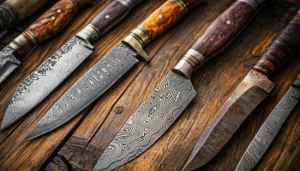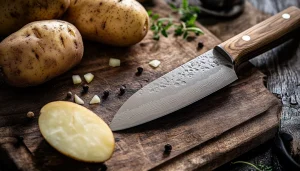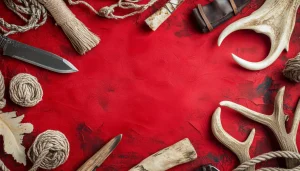Let’s Talk Knives
Ever wanted to create a knife that would better suit your needs and preferences? The creation of a knife is quite fascinating, allowing you to release your creativity and skill in making that perfect blade. Whether one is a professional custom knife maker or a new individual looking to try one’s hand at a new hobby, custom knife making has the potential to be a very rewarding and fulfilling experience. This blog will discuss the basics of making custom knives, from material selection to technique. Welcome to the journey of crafting your perfect blade!
Why Make Your Own Blade?
Hello, knife lovers! Ever thought why that should be cool to create a blade yourself? Well, I’ll get it explained to you in detail: When you make your custom knife, it is not just a tool but you’re making a statement. That is, as pertains to your style, preferences, and personality. Another thing, the satisfaction you get from using a blade you’ve worked on with your hands is unparalleled.
- Personalization: Having your custom knife commissioned gives you the ability to tailor it into something distinctive in your style and preference. You will be able to pick the material of the handle, the shape of the blade, and the overall design that fits you best and pleases your eye. This would definitely mean having a knife suited only for you.
- Quality and Craftsmanship: For the most part, custom knives are handcrafted by artisans who take pride in their work. That alone should guarantee a great deal more quality and attention to detail in a custom knife than some from the assembly line. The materials used are superior most of the time, and the blade is usually heat-treated and tempered for performance. Because of this, a custom knife can be an assurance that you are getting something that is high quality and may be expected to last long.
- Functionality and Performance: You could design and craft a custom knife for your specific needs and intended use. A knife could be tailored for everyday tasks, hunting, camping, even to tactical applications-end. What is required to have excellent performance in the application desired. You can choose the best blade steel, grind, and edge geometry for your intended use, making sure you will have a functional knife that is high performing. At the end, this can upgrade your overall experience and satisfaction with your blade, brought in by just an investment in a custom knife.
Priceless, right? Well, now buckle up and enter the world of custom knife making to unleash the artist inside you. Believe me, once you get started, there’s no stopping! Stay tuned for more tips and tricks in the quest to craft your perfect blade. Let’s get this on!
Getting Started: Choosing Your Materials
Get a little dirty with us as we take a deep dive, headfirst, into the world of custom knife making. Step number one? Choosing your materials. Every decision-from the type of steel you use all the way to the material of your handle-helps shape the final masterpiece. Are you leaning toward sleek and shiny with a Damascus steel blade, or more rugged with a carbon steel blade? And the handle-what would you like: classic wood or modern G10? The options are endless, so take your time and pick what speaks to your inner knife-making soul.
Here are some metal suggestions for your custom knife making, along with their benefits, use cases, and downsides:
Stainless Steel
- Benefits: Stainless steel is highly resistant to corrosion, making it a durable choice for handmade knives. It requires less maintenance and is easy to clean.
- Use Cases: Stainless steel knives are versatile and can be used for various tasks, including slicing, chopping, and dicing.
- Downsides: Stainless steel may not hold its edge as well as other types of steel, requiring more frequent sharpening.
Damascus Steel
- Benefits: Damascus steel is known for its beautiful and unique patterns, making each knife a work of art. It also offers excellent edge retention and durability.
- Use Cases: Damascus steel knives are often used for decorative purposes, as well as for precision cutting tasks.
- Downsides: Damascus steel can be more expensive compared to other types of steel. It may also require special care to maintain its appearance.
Carbon Steel
- Benefits: Carbon steel blades are known for their exceptional sharpness and edge retention. They are also relatively easy to sharpen.
- Use Cases: Carbon steel knives are commonly used by professional chefs and culinary enthusiasts who require precise cutting performance.
- Downsides: Carbon steel is prone to corrosion and requires regular maintenance to prevent rusting. It may also react with acidic foods, affecting the taste.
High Carbon Stainless Steel
- Benefits: High carbon stainless steel combines the best qualities of carbon steel and stainless steel. It offers excellent sharpness, edge retention, and corrosion resistance.
- Use Cases: High carbon stainless steel knives are suitable for a wide range of cutting tasks, from everyday kitchen use to outdoor activities.
- Downsides: High carbon stainless steel knives can be more expensive compared to other options. They may also require regular sharpening to maintain their performance.
Remember, the choice of metal for your custom knife depends on your personal preferences, intended use, and budget. Consider the benefits and downsides of each option before making a decision.
Personalize Your Piece: Adding Unique Touches
Now, the exciting part-adding that personal touch to your blade, making it different from all others: intricate engravings, adorning the knife handle with exotic materials, or etching on a meaningful symbol-this is where the real magic begins in making the knife truly yours. Let your imagination run wild, get creative-this is your custom creation; don’t hold back!. Take that piece of metal and turn it into art, reflecting yourself and your fashion.
Honing Your Skills: Tips for Beginner Bladesmiths
Time to sharpen those skills… Don’t fret if this is your first rodeo in the world of custom knife making. Remember, practice makes perfect! Start with simpler designs before diving into complex patterns. Take your time to master the basics like shaping the blade and handling the tools with precision. Don’t rush the process; enjoy the journey of crafting your unique blade. Seek inspiration from seasoned makers, watch tutorials, and don’t be afraid to make mistakes – it’s all part of the learning curve. With dedication and patience, you’ll soon be creating blades that’ll leave everyone in awe!
Here are 5 helpful tips for beginner bladesmiths to improve their skills:
Start with Simple Designs:
- Begin your knife-making journey by starting with simpler designs. This will allow you to focus on mastering the fundamental techniques and build your confidence.
- Starting with simple designs will also help you understand the basic principles of blade geometry and ensure a successful outcome.
Master the Basics
- Take the time to master the basics of knife making, such as shaping the blade and handling the tools with precision. These foundational skills will serve as the building blocks for more complex projects.
- Practice different techniques, such as grinding, heat treating, and handle shaping, to develop a solid understanding of the entire knife-making process.
Embrace Mistakes and Learn from Them
- Don’t be afraid to make mistakes along the way. Mistakes are valuable learning opportunities that can help you improve your skills.
- Analyze your mistakes, understand what went wrong, and make adjustments for future projects. Embracing mistakes will accelerate your growth as a bladesmith.
Seek Inspiration and Learn from Seasoned Makers
- Seek inspiration from experienced bladesmiths and knife makers. Study their work, techniques, and designs to broaden your knowledge and understanding of the craft.
- Attend workshops, conferences, or join online communities to connect with other bladesmiths. Learning from seasoned makers can provide valuable insights and guidance.
Enjoy the Journey
- Knife making is a journey that requires dedication and patience. Enjoy the process of crafting your unique blade and appreciate the skills you develop along the way.
- Don’t rush the process; take your time to ensure each step is done with care and precision. The journey itself is as rewarding as the final result.
- Remember, improving your skills as a bladesmith takes time and practice. Stay committed, be open to learning, and embrace the challenges. With perseverance, you’ll continue to grow and create blades that showcase your craftsmanship.
Show Off Your Creation: Sharing Your Custom Knife
Now that you’ve forged your blade, go out and show it off. Be proud; show it to fellow makers and knife enthusiasts alike. You can post pictures on social media forums for reviews, or even just attend a local craft fair to showcase your work. Let the fruits of your labor be seen and admired by others. But who knows? Your custom knife could be the factor that pushes another on to seek blade-making as a hobby. So go ahead, polish that beauty, show it off with pride, and let the world ogle at your craftsmanship!
Time to Get Crafting!
All right, folks! Now that you’ve flexed your finished work, back to the grindstone to continue the joy of making a knife! Start bringing out the tooling, selecting your materials, and let the crafting begin. Be sleek, rugged, cleaver, or flashy collector’s item, dive head-first into the process with verve. Enjoy this creation for taking raw materials and turning them little by little into a work of sharp art. Don’t forget to crank up the tunes, have some snacks on standby, and lose yourself in the creative flow. Let’s see what incredible blades you’ll bring to life next!




